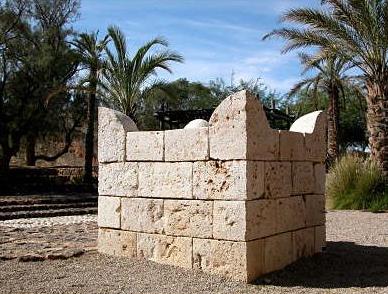Large Horned Altar. Photo courtesy of BiblePlaces.com.
While no complete large horned altar has been uncovered, finely hewn stones and “horns,” half-crescent shaped stones that protrude up and point in from the four corners at the top of the altar, allow reconstructing large horned altars. After producing a model of the Beer Sheba altar (pictured) archaeologists uncovered additional stones demonstrating that the Beer Sheba altar measured significantly wider than the reconstruction – nearly nine feet wide and approximately five feet high. An incised squiggle likely representing a snake slithered across a corner stone. Other than this incision the stones were plain with no decoration or writing.
In addition to the Tel Beer Sheba stones, which date to sometime between the 10th and the 8th c. BCE, “horn” stones of similar dimensions have been found at 10th c. Megiddo and 9-8th c. Tel Dan. The original context for the Beer Sheba altar cannot be determined; the stones were found reused as building stones in a storehouse wall. However, at Tel Dan, the horn-shaped stone, without other associated stones, lay in the sacrificial area of the bamah/temple. Stones of each of the three examples were finely carved. These contrast with the unworked or plain field stones of large altars built without horns, such as the contemporary altar in the courtyard of the Tel Arad temple or the earlier altar on Mt. Ebal.
Large Horned Altars and the Bible
In the instructions for the Tent of Meeting and its accompanying objects, God instructs the Israelites to build an altar of acacia wood covered with bronze, and “make its horns on the four corners, the horns to be of one piece with it” (Exod 27-1-2). Horns may symbolize strength, as of a bull, understood as political or religious authority. Ancient near eastern gods such as the Ugaritic storm god Baal wore a crown with horns. For example, the prophet Daniel envisioned animal horns representing the kings of Media, Persia, and Greece (Daniel 8). The dimensions of the reconstructed altars are presumed to conform to biblical dimensions for stone altars, not wooden ones- five cubits long, five cubits wide, and three cubits high (roughly 7.5 feet square by 4.5 feet high). Surprisingly, the carved stones of these altars violate the biblical prohibition against building altars of hewn stone, “And if you make for me an altar of stones, do not build it of hewn stones; for by wielding your tool upon them you have profaned them” (Exodus 20-22).
Horned altars figure in several biblical accounts. King David’s son Adonijah and Joab, David’s commander in chief, grasped the horns of the altar for “sanctuary,” as refuge from those seeking to kill them (I Kings 1- 50-53; 2- 28). Amos foresaw Israel’s punishment with the horns of the altar of Bethel cut off and fallen to the ground (Amos 3-14) and Jeremiah envisioned Judah’s guilt “inscribed with a stylus of iron…on the tablet of their hearts and on the horns of the altar” (Jeremiah 17- 1).
Based on archaeological evidence, the Dan and Megiddo altars likely ceased to function with the destructive Assyrian campaign of 734 BCE. The excavator of Tel Arad, Y. Aharoni, suggested that the altar was dismantled in conformance with King Hezekiah’s late eighth or early seventh century BCE efforts to centralize worship and sacrifice in the Jerusalem temple ( II Kings 18-3-4). The archaeological evidence can not be dated with sufficient precision to date the altar’s end.
For a general discussion of altars read M. Fowler “Incense Altars” ABD III- 409-10 and R. Haak “Altar” ABD I- 162-67.Y. Aharoni presents the archaeological evidence in “The Horned Altar of Beer-Sheba” BA 37 (1974) 2-6.
Elizabeth Bloch-Smith
See also-
